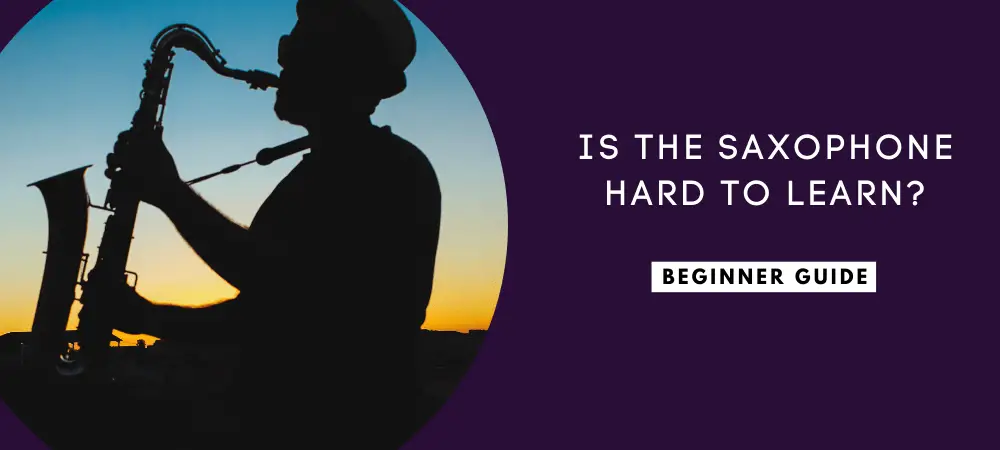Have you been contemplating playing the saxophone but have been questioning your capability? Well, learning to play the saxophone is not exactly hard.
If you can comfortably blow a little bit of air, then you should be able to play it. However, that doesn’t mean the saxophone isn’t challenging to master.
Actually, most learners find it easy to make a sound on the saxophone during their first practice session. They, however, agree that it’s challenging to make a good sound on that same day.
Nonetheless, this shouldn’t discourage you if you have been planning on taking saxophone lessons.
If anything, go for it. With the right attitude and steps, you can steadily progress your saxophone skills.
Yearning to learn more? Read on!
Table of Contents
Is the Saxophone Hard to Learn?
As already mentioned above, you should be able to produce a sound on your saxophone during your first day of practice. And that doesn’t necessarily have to be an excellent tune, but it will serve as a good beginning.
So, if you have already purchased your instrument and are trying to self-learn at home but can’t seem to get any sound out of it, something must be wrong.
You, therefore, have to learn the correct playing skills and techniques.
Lipping / Embouchure
Most of the time, it could be a little squeeze on both the mouthpiece and reed, due to too much pressure.
Therefore, you first have to know how to balance your jaw and lips on the instrument.
And this delicate but straightforward procedure of placing those lips on the mouthpiece is what is referred to as the embouchure in the musical world.
I must insist that the fact that this is the first skill you should learn also makes it the most important of them all.
Remember, your lip movements have a significant impact on the sounds you produce as you play the instrument. And this directly affects the quality of the tone.
Although you can’t master this skill in a day or two or even weeks, you should aspire to master the basic skills and keep advancing them over the years. Of course, under the guidance of an experienced saxophone coach.
With time, you will know how to apply various sound effects such as slap tonguing, growling, overtones, and split tones, among others.
Listen to this incredible sound effects:
Fingering
Still not convinced that you can actually play the saxophone with ease? Well, you need to know that not all individuals are the same.
Some learners will have ample time learning the instrument, while others will take ages to master even the most straightforward concepts.
But, if you have ever played any woodwind instrument before, then finding your way through the saxophone shouldn’t be that difficult. This is because the fingering skills you need remain pretty the same.
However, if you’re a total beginner, then you will have to learn how to finger appropriately. The most prominent mistake most beginners make is overdoing the bending and scooping of notes.
If you scoop a lot of notes, then you will come out strange. So, go slow on them by using curved hands, complete with some pads on the fingers.
Avoid placing your fingers flatly and using fingertips.
Also, always ensure your pinkies rest on the correct keys, with the left thumb resting on the round thumb, and the right thumb strategically placed under the thumb rest.
Don’t forget always to place your left hand on top.
But even as you do this, remember the saxophone isn’t one of those instantly gratifying instruments. You will have to practice frequently and persistently to develop an excellent tone.
Also, it’s easy for you to get frustrated if you don’t sound like your favorite musician within a month or two. Keep in mind that those players have been playing for years.
So, the best thing you can do for yourself is to set realistic goals.
Translating Lyrics
If you’re planning on using original voiced tunes, then you should also work on mastering the words so that you can know the correct way to use the rhythm and twisting the tune to suit your style.
And the best way to do this is by digging deeper into the reason behind the production of the song. This way, you can easily derive some inspiration from your past experiences in applying to correct emotions.
However, if you can’t seem to grasp the lyrics or don’t want to go that route, you can create your own and then apply a unique approach.
The most crucial thing is for you to be able to translate the lyrics into an instrumental melody.
Using Vibrato
Now that you have already learned how to properly embouchure and develop your sounds, it would be great if you spice up your tunes with some good vibrato.
Yes, all voices indeed exhibit some vibrato. And because of this, some saxophone players can instinctively play it, while others have to learn it either as adults or when young.
There are various approaches to this skill, and one cannot exhaustively say to have learned them all. But you can master the multiple abilities as you use your muscles to hold notes in a pitch.
For example, you can begin by outwardly holding up the note for a few seconds and then vibrato on it as you increase the intensity before releasing it.
The best thing is that there is no specific rule when it comes to vibrato-ing. Simply be conscious about how you’re going to use it to achieve an accurate representation of your feelings.
Check out this vibrato tutorial for some fantastic tips:
Of course, there are many more skills you should learn, such as adding various elements using dynamics, painting a story-picture as you play, and many more.
But you can’t ponder on everything right away.
The crucial point is for you to realize that to learn the saxophone, you will have to use various skills. How faster you master them will determine whether you find playing hard or easy.
How Long Does It Take to Learn the Saxophone?
I usually find this question quite broad. So it’s always impossible to give an accurate answer right away without considering various factors.
First, I would like you to know that there’s a significant difference between learning to play the saxophone with minimal wrong notes and playing it comfortably with no trace of wrong notes.
Therefore, you first have to set a goal. For example, what do you want to achieve by the end of the first training session or the first week, month, etc.?
While at it, try to be as realistic as possible.
If you are a young student of around 20 years or so and wouldn’t mind spending the rest of your life getting better at the instrument, then you obviously have more time to better yourself and become a top professional.
But, if you’re around 40+, with a family and a demanding full-time job, you won’t have much time to dedicate to learning the saxophone. So, it would be unrealistic to expect to be ready for a jazz festival within a year or even two.
You see, if you have a lot of time to practice, are a fast learner and highly enthusiastic, then you should be able to play in an ensemble within 2-4 years.
Therefore, before you ask, “how long does it take to learn the saxophone?” you should first be able to answer “how much practice time am I willing to set aside to help me achieve my goal?”
Remember, for any musical instrument, the rule has always been one: the more you practice, the more comfortable you get with the device, and the quicker you will master it.
So, to answer your question, the amount of time you will take learning the saxophone largely depends on your goal. If you want to be a professional, then that translates to years.
But, if you will be okay with simple good tunes, then that can be done within a few months even.
How Do You Get Good at Saxophone?
Every great saxophone musician you see out there was once a beginner. And what separates them from others is the amount of effort they used to improve their performances gradually.
So, if your goal is to be ranked among the great, here are a few tips to help you get there:
-
Have A Fingering Chart
If you’re learning to play your saxophone, then you will be using various musical pieces in your practice sessions, from time to time.
And since not all composers are the same, some pieces might lack a few notes while others have a little bit more.
Therefore, you need to possess a fingering chart. And that’s not all. Ensure you hang it where you can see it daily.
The best place for this is on the wall or door of your practicing room (if you have any) or any other place where you frequently practice.
This way, you will keep a mental list of all the high notes you can apply even when you don’t need them in your current musical pieces.
If you let yourself forget the existence of some notes, you won’t use them even when necessary, and that works against your growth.
You can always purchase one from a local music store. They are generally cheap and easily portable.
-
Wet Those Reeds During Each Practice Session
Most Saxophone players I see, hold their reeds in their mouth as they assemble the rest of the parts, every time they want to play.
If you can’t stand anything (apart from food) in your mouth, then you can use a little bit of water to wet it.
The primary reason behind this is that it enhances the reed vibrations as you play. And that will significantly improve the quality of the sound produced.
-
Invest in Quality Reeds
If you can afford to buy a quality instrument, then nothing should prevent you from investing in a top-notch reed.
The last thing you want is to have the reed splinter in your mouth as you play. I will hurt, and you won’t like the test either.
Any experienced saxophone player will tell you that an exploding reed is not only disastrous but also very frustrating.
Besides, a high-quality reed also positively impacts the quality of tone produced. If you have been using a low quality one, then you will undoubtedly notice a significant improvement.
Therefore, sometimes it really isn’t you who doesn’t know how to blow, but your instrument’s reed that’s letting you down.
For best reeds, always consider cane-made or one made with any other natural material. The fiberglass reeds won’t do you justice.
-
Use A Neck Strap
Yes, you might be feeling comfortable playing your saxophone without a neck strap while sitting at your favorite spot, but have you tried this while standing?
Take it from me. It won’t be easy. You will find yourself struggling to balance it.
A neck strap will come handy to help you evenly distribute the instrument’s weight off your thumbs. And as you do so, you will realize that your fingers can now move swiftly and effectively.
Some instruments come with neck-straps as part of their extra accessories. But if yours doesn’t have, you can always purchase one from your local music store. They aren’t expensive.
-
Learn the Art of Ligature Tightening
There’s nothing as frustrating to a saxophone player than that dreadful water-associated noise that comes from under the reed.
It can completely ruin the entire performance. And the worst thing is that it’s almost impossible for you to stop playing at the center of an exciting piece.
So what can you do to salvage the situation?
Apply this trick: focus on giving your ligature joint another half turn. Your heart will sing with joy at the results.
What’s the Best Saxophone for A Beginner?
Generally, there are four types of saxophones. And they include the Soprano saxophone, the tenor saxophone, the baritone saxophone, and the alto saxophone.
But among the four, the alto saxophone has always been known to be the best for beginners.
This is primarily because they can be readily found in various local music stores. They are pretty affordable and easy to learn.
Also, they are mainly used in various jazz tracks, so it will be easy for you to listen to their sounds as you begin your learning journey.
FAQs About How Hard It Is to Learn the Saxophone
Can I Learn Saxophone on My Own?
There is no absolute correct or wrong way to learn how to play the saxophone. Therefore, if you feel that teaching yourself is the best way to do it, then, by all means, go for it.
There are various resources on the internet that you can use in your sessions. YouTube, for example, has a wide range of beginner-friendly videos. Take advantage of that.
Remember, it’s all about you and your best interest. So have some fun while at it and keep practicing. You can even pair with a friend for accountability purposes.
How Much Should I Spend on A Saxophone?
If you’re a new saxophone student, then you can readily find a quality good branded saxophone from around $1000 9alto Sax).
But if you want to start with tenor, then a budget of about $1200 will be fine.
And for on-budget learners, you can also opt for a used saxophone (of course should be in good condition) which will cost $300+
If you settle for a used one, remember to conduct due diligence with the help of a professional. There are a lot of cons out there, and you don’t want to fall, the victim.
How Many Hours A Day Should I Practice Saxophone?
As a beginner, you would want to start slow and build up your stamina with time.
So, no matter how excited you might be about your new adventure, restrain from practicing for long hours.
I have seen some beginners say they spent 10 hours on the first day. And while that can give impressive progress, it’s unrealistic for a starter.
Therefore, the best time should be around 10-15 minutes a day for 6 days a week, or you can do 30 minutes a day for 3 days a week. And then work on practicing more as you progress.
But, if possible, practice every day, even if it’s for a few minutes no matter how tight your schedule is, to keep your fingers and brain active.
Is It Too Late to Learn Saxophone?
Honestly, it’s never too late to learn a saxophone or any other instrument for that matter.
Age shouldn’t be a limit. As long as you can comfortably blow air, then you can play the saxophone.
And yes, the mastering speed might differ with those of your younger friends, but you can get there with persistence.
Conclusion
Learning any new instrument, including the saxophone, isn’t easy. After all, it’s a fresh concept, and you will have to get your brain accustomed to it.
But that shouldn’t be a barrier. If others were able to learn, then so can you. You simply have to remain positive and focused.
There are also a few useful skills you should learn to make your work easier. I mentioned them in the article so you should be well informed.
Don’t forget to apply the excellent tips I gave, and you won’t even realize how fast you master your instrument.
And remember to have fun while at it!


![How to Learn Saxophone by Yourself? [Beginner Guide]](https://musictechhub.com/wp-content/uploads/2020/04/How-to-Learn-Saxophone-by-Yourself-250x170.png)

